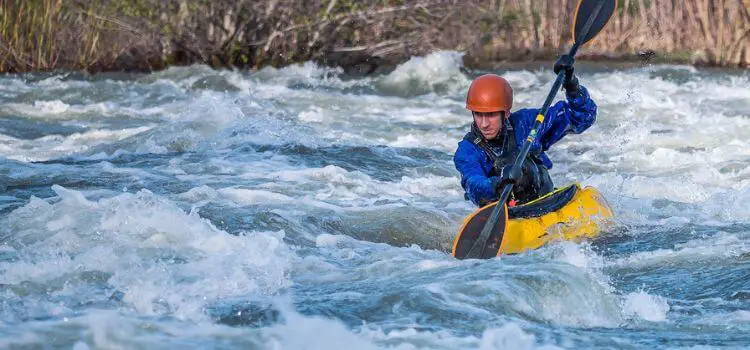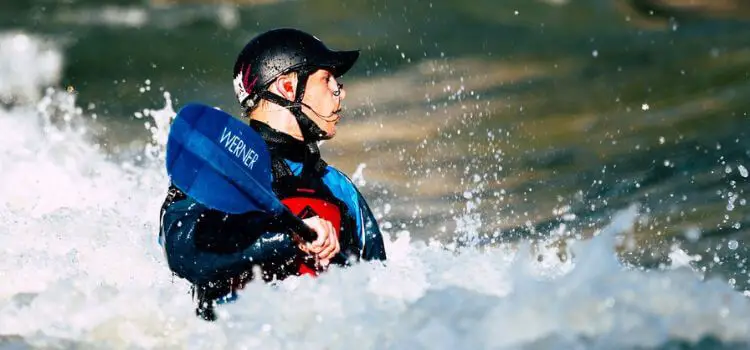As an Amazon Associates, I earn from quality purchases.
In the realm of kayaking, one popular comparison stands out: dry suit vs wet suit kayaking. But which one should you choose? In a nutshell, a dry suit is designed to keep you completely dry, providing an impermeable barrier against water. On the other hand, a wet suit allows a small amount of water to enter and then traps and warms it. It creates a thin layer of insulation between your body and the surrounding water.
So, if you’re looking for maximum protection against cold and wet conditions, a dry suit is the way to go. However, if you’re more focused on flexibility and breathability, a wet suit might be a better choice.
So, let’s dive into this exciting journey. Prepare to learn, compare, and decide which suit will accompany you on your thrilling kayaking expeditions.
Comparison Table between Dry Suit vs Wet Suit:
Dry Suit | Wet Suit |
Designed to keep you completely dry | Designed to keep you wet but insulated |
Made of thicker material for added protection | Made of thinner, flexible material |
Keeps you warm in cold water and weather | Provides some insulation but not as effective in extreme cold |
Provides buoyancy and helps you float | Provides less buoyancy than a dry suit |
Can be less flexible and restrict movement | Allows for greater mobility and flexibility |
Ideal for kayaking in cold water or chilly weather | Ideal for warmer waters and moderate weather |
More expensive than wet suits | Generally more affordable |
Requires additional layers for insulation | Can be worn with minimal layers underneath |
Requires proper care and maintenance | Requires proper care and maintenance |
What is a Dry Suit?

Definition of a Dry Suit
A dry suit is like a superhero suit for kayakers! It’s a special outfit made of waterproof material that keeps you completely dry even when you’re surrounded by water. Just imagine wearing a raincoat that covers your whole body, including your arms and legs. Pretty cool, right?
How Does a Dry Suit Work?
A dry suit has special seals around the neck, wrists, and ankles that keep water from sneaking inside. It’s like wearing a strong rubber band that hugs your body tightly to keep water out. The suit also has a handy zipper that goes all the way up to your neck, just like a turtle hiding in its shell.
Examples of Dry Suits
Some dry suits even have a built-in air valve. This little gadget allows you to blow air into your suit and create a protective cushion around your body. It’s like having your bubble in the water! How awesome is that?
When to Wear a Drysuit Kayaking?
When it comes to wearing a drysuit for kayaking, there are a few key situations where it’s a great idea:
1. Cold Weather:
If you’re going kayaking in chilly or cold weather, a dry suit is a must-have. It provides insulation and keeps you warm, even when you’re surrounded by cold water.
2. Cold Water:
Similarly, if you’re paddling in cold water, a dry suit is essential. Cold water can quickly drain your body heat, so wearing a dry suit helps maintain a comfortable temperature and prevents hypothermia.
3. Rough Water:
If you’re planning to tackle rough or choppy water conditions, a dry suit can be a lifesaver. It keeps you dry even if you get splashed or go overboard, ensuring your safety and comfort.
4. Extended Kayaking Trips:
For longer kayaking trips where you may not have immediate access to shelter or warm clothing, a dry suit provides an extra layer of protection against the elements. It’s like having your shield against the cold and water.
Remember, safety should always be a priority, and wearing a drysuit in appropriate conditions ensures a more enjoyable and risk-free kayaking experience.
What to Wear under a Dry Suit Kayaking?
Now, let’s talk about what to wear underneath your drysuit to ensure maximum comfort and functionality:
1. Base Layers:
Wear thin, moisture-wicking base layers made of materials like polyester or merino wool. These layers help regulate your body temperature and keep you dry by wicking away sweat.
2. Insulating Layers:
Depending on the weather and water temperature, add insulating layers like fleece or synthetic insulation. These layers provide additional warmth without adding bulk or restricting movement.
3. Socks:
Opt for thin, synthetic, or wool socks that provide insulation and moisture-wicking properties. Avoid cotton socks as they can retain moisture and make your feet cold.
4. Gloves and Hat:
Don’t forget to protect your extremities! Wear waterproof gloves and a hat to keep your hands and head warm. These accessories are essential for overall comfort and maintaining body heat.
5. Footwear:
Choose neoprene booties or waterproof shoes to keep your feet warm and protected. Make sure they fit comfortably inside your kayak and work well with the socks you’re wearing.
The key is to layer your clothing appropriately based on the weather and water conditions. Avoid wearing too many bulky layers that can restrict movement or make you uncomfortable. Finding the right balance ensures a pleasant kayaking experience.
So, gear up, little adventurers, wear your dry suit in the right conditions, and dress smartly underneath for a fantastic kayaking adventure!
At what temperature do I need a dry suit for kayaking?
The need for a dry suit in kayaking depends on several factors, including personal tolerance, water temperature, air temperature, and the duration of your kayaking activity. While specific preferences may vary, here are some general guidelines for when a dry suit is typically recommended:
1. Cold Water Temperatures:
If you plan to kayak in water temperatures below 50°F (10°C), a dry suit is highly recommended. These frigid temperatures can quickly lead to hypothermia, and a dry suit provides excellent insulation and protection against cold water.
2. Cold Air Temperatures:
Even if the water temperature is not extremely cold, if the air temperature is chilly and there’s a chance of getting wet, a dry suit is a wise choice. The combination of cold air and wet clothing can make you feel cold and uncomfortable, increasing the risk of hypothermia.
3. Extended Exposure:
If you’re planning a long kayaking trip or expect to spend an extended period in the water, a dry suit is beneficial. It provides continuous protection and keeps you dry throughout your adventure, regardless of the temperature.
4. Rapidly Changing Conditions:
In situations where the weather or water conditions can change rapidly, a dry suit offers versatility and adaptability. It ensures you’re prepared for any sudden drops in temperature or unexpected water immersion.
It’s always essential to assess the specific conditions and use your judgment to determine whether a dry suit is necessary for your safety and comfort.
Stay safe, keep an eye on the temperature, and choose the appropriate gear to make your kayaking experience enjoyable and worry-free!
What is a Wet Suit?

Definition of a Wet Suit
Now, let’s talk about wet suits! A wet suit is like a cozy blanket that keeps you warm when you’re in the water. It’s made of a special material that traps a thin layer of water between the suit and your skin. This water gets warmed up by your body heat and keeps you nice and toasty!
How Does a Wet Suit Work?
A wet suit is made of a stretchy material called neoprene. It’s like a second skin that fits snugly around your body. When you jump into the water, a small amount of water enters the suit. Your body heats this water, creating a warm layer that keeps you from feeling chilly.
Examples of Wet Suits
Wet suits come in all sorts of colors and patterns. You can even find suits with fun designs like sharks or mermaids. It’s like wearing a super cool costume while having fun in the water!
Is a Wetsuit Good for Kayaking?
Yes, a wetsuit is indeed good for kayaking, especially in certain conditions. Let’s explore why:
1. Insulation:
A wet suit offers warmth and insulation by creating a slim water layer that gets trapped between your skin and the suit. Your body heat warms up this water, creating a protective barrier that keeps you warm even in cooler waters.
2. Flexibility and Mobility:
Wetsuits are designed to be flexible, allowing for a wide range of movement. This flexibility is ideal for kayaking, as it allows you to paddle freely and comfortably without restrictions.
3. Protection from UV Rays:
Wetsuits offer protection from the sun’s harmful UV rays. When you’re out on the water for extended periods, the wetsuit acts as a barrier, shielding your skin from sunburn and potential long-term damage.
4. Abrasion Resistance:
Kayaking involves contact with the water, kayak, and sometimes rough surfaces. Wetsuits are made of durable materials that provide a certain level of abrasion resistance, protecting your skin from scratches and minor scrapes.
5. Buoyancy:
Although not as buoyant as dry suits, wetsuits provide some degree of buoyancy. This buoyancy can help assist your swimming abilities and keep you afloat if needed.
However, in colder waters or during cooler weather, a wetsuit may not provide sufficient insulation, and a dry suit may be a better choice to keep you warm and dry.
Ultimately, it’s essential to assess the specific conditions you’ll be kayaking in and choose the appropriate gear accordingly. Stay safe, have fun, and enjoy your kayaking adventures!
Dry Suit vs Wet Suit: The Differences
Now that we know what dry suits and wet suits are, let’s compare them and see how they’re different from each other.
Keeping Dry vs Keeping Warm
A dry suit’s main job is to keep you dry, like a superhero shield against water. On the other hand, a wet suit is all about keeping you warm and cozy, like a snug blanket. So, if you don’t want to get wet at all, a dry suit is your best friend. But if you’re okay with a little bit of water and want to stay warm, a wet suit is the way to go.
Material and Design
Dry suits are usually made of thicker material and have extra layers for added protection. They are like a fortress that keeps water away. Wet suits, on the other hand, are made of thinner material and are more flexible, allowing you to move around easily.
Buoyancy
Did you know that dry suits are more buoyant than wet suits? It’s like wearing a life jacket under your suit. This extra buoyancy helps you float on the water without much effort. Wet suits, however, are not as buoyant because they are designed to keep you closer to the surface.
Mobility
When it comes to moving freely in the water, wet suits are the winners. They are more flexible, allowing you to bend your arms and legs easily. Dry suits, although they keep you dry, can be a bit stiff and restrict your movements.
Ideal Conditions
Dry suits are perfect for kayaking in cold water or chilly weather. They provide excellent protection against the cold and keep you dry even if you accidentally fall into the water. Wet suits, on the other hand, are great for warmer waters, where the focus is on staying comfortable and enjoying the splash!
Choosing the Right Suit

Now that you know the differences between dry suits and wet suits, how do you choose the right one for your kayaking adventure? Let’s find out!
Temperature and Water Conditions
Think about the temperature of the water you’ll be kayaking in. If it’s cold, a dry suit is the way to go. But if it’s relatively warm, a wet suit will keep you comfortable and protected.
Personal Preference
What makes you feel the most comfortable? Some kayakers prefer the dryness of a dry suit, while others enjoy the coziness of a wet suit. It’s all about what you feel comfortable with you!
Budget
Dry suits tend to be more expensive than wet suits. So, if you’re on a tight budget, a wet suit might be a more affordable option. Remember, it’s not about the price tag, but about having a great time on the water!
Related Topic: What To Wear When Kayaking Summer.
Conclusion
Well, little adventurers, now you know all about dry suits and wet suits! Dry suits are like magical raincoats that keep you completely dry, while wet suits are like warm blankets that keep you cozy. Depending on the water conditions and your personal preferences, you can choose the perfect suit for your kayaking adventures. So, go out there, have a splash, and enjoy the wonders of kayaking!
Frequently Asked Questions (FAQs):
Q: Can I wear a dry suit in warm weather?
Of course, you can wear a dry suit in warm weather, but you might feel too hot and sweaty. Dry suits are designed for colder conditions, so a wet suit or lighter clothing might be more suitable for warmer weather.
Q: Can I wear a wet suit in cold water?
While a wet suit provides some insulation, it might not be enough to keep you warm in cold water. In such extreme conditions, a dry suit is the better option to ensure your safety and comfort.
Q: Can I wear clothes under a wet suit?
Yes, you can wear a thin layer of clothing, such as a swimsuit or rash guard, under your wet suit. It helps prevent chafing and adds an extra layer of insulation.
Q: Can I use a dry suit for other water activities besides kayaking?
Absolutely! Dry suits are versatile and can be used for various water activities like paddle boarding, sailing, or even diving. They provide excellent protection against water and keep you dry and comfortable.
Q: How do I take care of my dry suit or wet suit?
To take care of your suit, rinse it with fresh water after each use to remove salt or dirt. Hang it to dry in a shaded area, away from direct sunlight. Avoid using harsh detergents or chemicals, as they can damage the fabric.

Leave a Reply